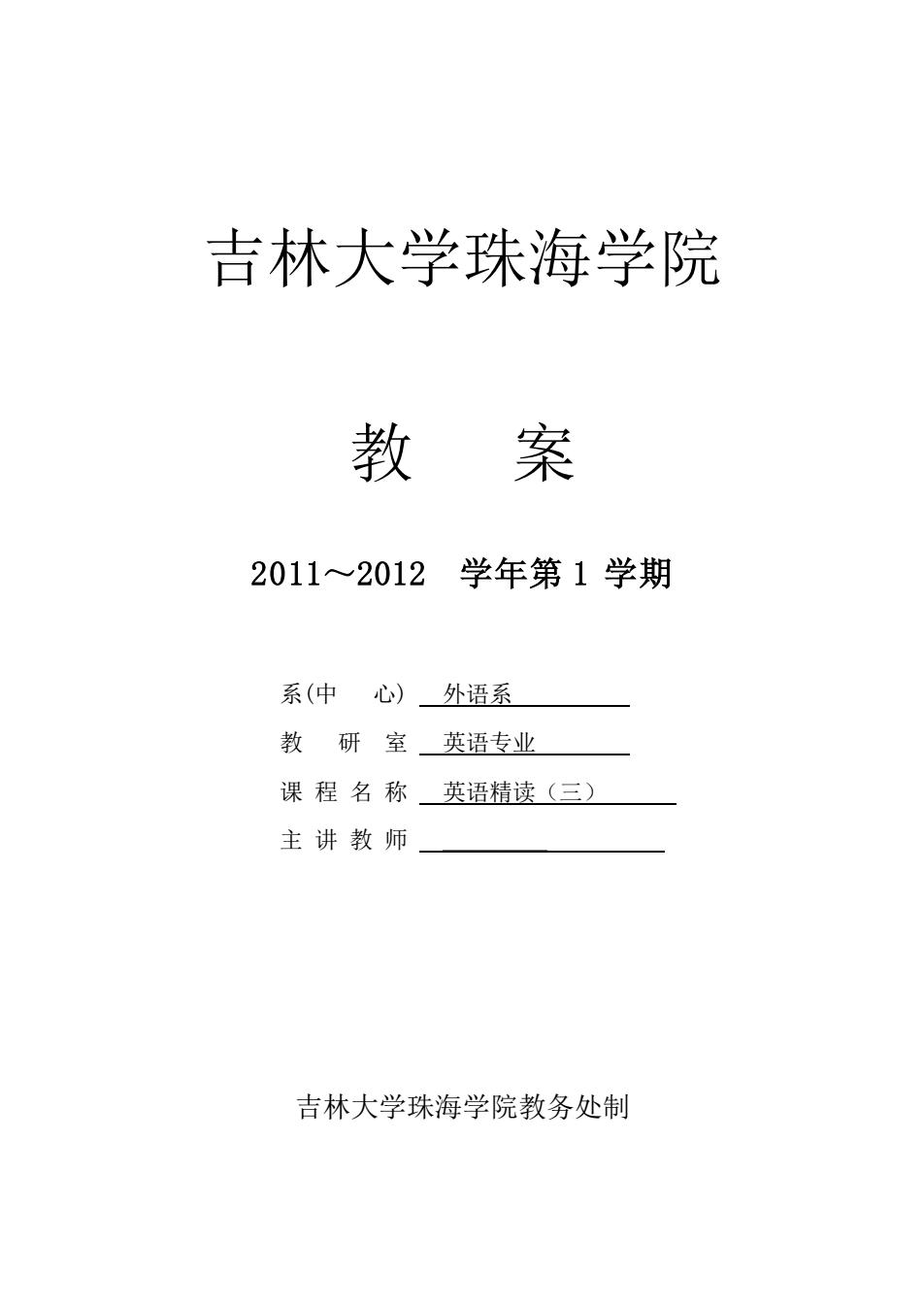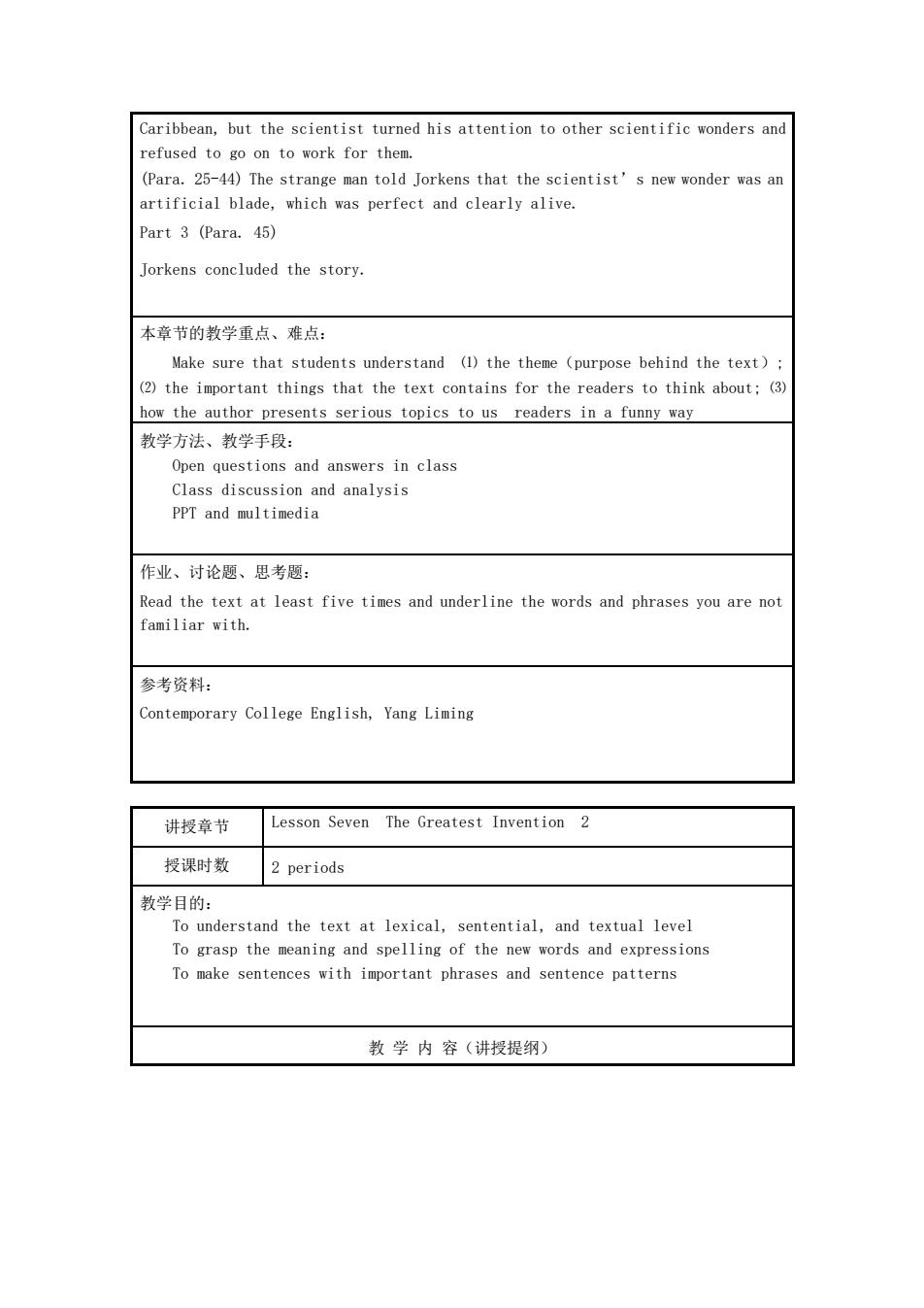
吉林大学珠海学院 教案 2011~2012学年第1学期 系(中心)外语系 教研室英语专业 课程名称英语精读(三) 主讲教师 吉林大学珠海学院教务处制
吉林大学珠海学院 教 案 2011~2012 学年第 1 学期 系(中 心) 外语系 教 研 室 英语专业 课 程 名 称 英语精读(三) 主 讲 教 师 _ 吉林大学珠海学院教务处制

讲授章节Lesson Seven The Greatest Invention 1 授课时数 2 periods 教学目的: Grasp the meaning of the text Analysize the text (main idea,structure) Learn more about fable and parable 教学内容(讲授提纲) I.Warming-up questions 1.Do you still remember the September 11 incident?Why do you think those terrorists can bring about such incidents? 2.What's the driving force of scientific development? 3.What's the purpose of science? 4.Since science is a double-edged sword,what should scientists do? II.About the author and the text ppt IlI.Understanding of the text The main idea A man,who had worked in the Ministry of Warfare of his country,believed that modern science had given small countries like theirs the power to conquer the world. They had a great scientist who had discovered a most deadly germ and a most effective way to spread it.But the scientist suddenly lost interest in this and turned his attention to other scientific wonders.In spite the man tried everything he could, the scientist refused to give up his wonderful research project just to please the overnment and help the government to develop a deadly weapon forworld domination. Finally the man's government had to execute the scientist and thus their marvelou plan failed. 2.Style The story was originally told by the strange man and retold by Jorkens.The whole story is written in the direct speech,thus the write adopts a colloquial style. 3.Structure Part 1 (Para.1-4) Jorkens talked with his friends at their club about the international situation. Part 2 (Para.5-44) (Para.5)Jorkens went to a port in the tropics where he met with a strange mar (Para.6-24)The strange man told Jorkens a story:He and his government had a great scientist and wanted the scientist's discovery to help them conquer the whole
讲授章节 Lesson Seven The Greatest Invention 1 授课时数 2 periods 教学目的: Grasp the meaning of the text Analysize the text (main idea, structure) Learn more about fable and parable 教 学 内 容(讲授提纲) I. Warming-up questions 1. Do you still remember the September 11 incident? Why do you think those terrorists can bring about such incidents? 2. What’s the driving force of scientific development? 3. What’s the purpose of science? 4. Since science is a double-edged sword, what should scientists do? II. About the author and the text ppt Ⅲ. Understanding of the text 1. The main idea A man, who had worked in the Ministry of Warfare of his country, believed that modern science had given small countries like theirs the power to conquer the world. They had a great scientist who had discovered a most deadly germ and a most effective way to spread it. But the scientist suddenly lost interest in this and turned his attention to other scientific wonders. In spite the man tried everything he could, the scientist refused to give up his wonderful research project just to please the government and help the government to develop a deadly weapon for world domination. Finally the man’s government had to execute the scientist and thus their marvelous plan failed. 2. Style The story was originally told by the strange man and retold by Jorkens. The whole story is written in the direct speech, thus the write adopts a colloquial style. 3. Structure Part 1 (Para. 1-4) Jorkens talked with his friends at their club about the international situation. Part 2 (Para. 5-44) (Para. 5) Jorkens went to a port in the tropics where he met with a strange man. (Para. 6 –24) The strange man told Jorkens a story: He and his government had a great scientist and wanted the scientist’s discovery to help them conquer the whole

Caribbean,but the scientist turned his attention to other scientific wonders and refused to go on to work for them. (Para.25-44)The strange man told Jorkens that the scientist's new wonder was an artificial blade,which was perfect and clearly alive. Part 3 (Para.45) Jorkens concluded the story. 本章节的教学重点、难点: Make sure that students understand (1)the theme (purpose behind the text) (2)the important things that the text contains for the readers to think about:(3) how the author presents serious topics to us readers in a funny way 教学方法、教学手段: Open questions and answers in class Class discussion and analysis PPT and multimedia 作业、讨论题、思考题 Read the text at least five times and underline the words and phrases you are not familiar with. 参考资料: Contemporary College English,Yang Liming 讲授章节Lesson Seven The Greatest Invention2 授课时数2 periods 教学日的. understand the text at lexical,sentential,and textual level To grasp the meaning and spelling of the new ords and expressions To make sentences with important phrases and sentence patterns 教学内容(讲授提纲)
Caribbean, but the scientist turned his attention to other scientific wonders and refused to go on to work for them. (Para. 25-44) The strange man told Jorkens that the scientist’s new wonder was an artificial blade, which was perfect and clearly alive. Part 3 (Para. 45) Jorkens concluded the story. 本章节的教学重点、难点: Make sure that students understand ⑴ the theme(purpose behind the text); ⑵ the important things that the text contains for the readers to think about; ⑶ how the author presents serious topics to us readers in a funny way 教学方法、教学手段: Open questions and answers in class Class discussion and analysis PPT and multimedia 作业、讨论题、思考题: Read the text at least five times and underline the words and phrases you are not familiar with. 参考资料: Contemporary College English, Yang Liming 讲授章节 Lesson Seven The Greatest Invention 2 授课时数 2 periods 教学目的: To understand the text at lexical, sentential, and textual level To grasp the meaning and spelling of the new words and expressions To make sentences with important phrases and sentence patterns 教 学 内 容(讲授提纲)

Explanation of the text Part 1 (Paral-4) Comprehensive questions 1. What were these people talking about?Who were they? The members of the club were talking about the international situation. What's Jorken's opinion about the situation of the world? In his opinion,it was hard to find out what any country could do or would do next. Language points and sentence structures 1. in the old days:in the past. People in the old days seemed to be more polite. have a rough idea of:not in detail I have a rough idea where it is. 3.Analyze "Now that.do next"and find out what's the implication of the sentence. Difficulties:a.“abob”is the object of“carry'”.To avoid discontinue modifiers,we can't say "carry a bomb in a bag that:To abide by the principle of end-weight and to avoid ambiguity,we'd better not say "carry a bomb that. in a bag”, b.“it”is an introductory word. Imlication:When the technology for producing these terrible weapons is so easily available,the threat to the safety of the people in the world is only too real and no longer science fiction. Par 2 (Para.5-45) (Para 5) Language points and sentence structures 1.put into (of a ship):to enter (a port) 2.go ashore:go to the shore. is to form an adjective or an adverb. E.g.:asleep,awake,alive,aboard 3.decent: socially acceptable:not causing shame or shock to others Those tight pants of yours aren't decent.decent behavior b.infml.quite good You can get a decent meal there without spending too much money. c.infml.nice:kind. The policeman was really very decent to us. 4.turn out: a (T)to stop (a light,etc.) (I)to come out or gather as for a meeting,public event,etc. Crowds turned out for the procession. (T)to produce.This factory can turn out a hundred cars a day. d (I to -v.)to happen to be in the end
Explanation of the text Part 1 (Para1-4) Comprehensive questions 1. What were these people talking about? Who were they? The members of the club were talking about the international situation. 2. What’s Jorken’s opinion about the situation of the world? In his opinion, it was hard to find out what any country could do or would do next. Language points and sentence structures 1. in the old days: in the past. People in the old days seemed to be more polite. 2. have a rough idea of : not in detail. I have a rough idea where it is. 3. Analyze “Now that . do next” and find out what’s the implication of the sentence. Difficulties: a. “a bomb” is the object of “carry”. To avoid discontinued modifiers, we can’t say “carry a bomb in a bag that .; To abide by the principle of end-weight and to avoid ambiguity, we’d better not say “carry a bomb that . in a bag”. b. “it” is an introductory word. Implication: When the technology for producing these terrible weapons is so easily available, the threat to the safety of the people in the world is only too real and no longer science fiction. Par 2 (Para. 5-45) (Para 5) Language points and sentence structures 1. put into (of a ship): to enter (a port) The boat had to put into Sydney for supplies. 2. go ashore: go to the shore. “a-” is to form an adjective or an adverb. E.g.: asleep, awake, alive, aboard 3. decent: a. socially acceptable; not causing shame or shock to others. Those tight pants of yours aren’t decent. decent behavior b. infml. quite good You can get a decent meal there without spending too much money. c. infml. nice; kind. The policeman was really very decent to us. 4. turn out: a. (T)to stop (a light, etc.) b. (I) to come out or gather as for a meeting, public event, etc. Crowds turned out for the procession. c. (T) to produce. This factory can turn out a hundred cars a day. d. (I + to – v.) to happen to be in the end

His statement turned out to be false. The party turned out a success. e [usu.Pass.to dress.She was well turned out for the party. 4.call for order.ask for 5.Analyze“When the bottle.moustache” a. “had been”is omitted in“and the wine poured out" b. "like liquid tropical sunlight"suggests that the wine was pretty strong, like hot liquid sunlight 6.Notice the way Jorkens described this man.See Note 9 (Teachers'Book). 本章节的教学重点、难点: put into:go ashore;decent:turn out;call for 教学方法、教学手段: Open questions and answers in class Class discussion and analysis PPT and multimedia 作业、讨论题、思考题: Exercises:P177-190 参考资料: Contemporary College English,Yang Liming 讲授章节 Lesson Seven The greatest Invention 3 授课时数2 periods 教学日的: To understand the textat lexical,sentential,and textual level To grasp the meaning and spelling of the new words and expressions To make sentences with important phrases and sentence patterns 教学内容(讲授提纲)
His statement turned out to be false. The party turned out a success. e. [usu. Pass.] to dress. She was well turned out for the party. 4. call for : order, ask for 5. Analyze “When the bottle.moustache”. a. “had been” is omitted in “and the wine poured out” b. “like liquid tropical sunlight” suggests that the wine was pretty strong, like hot liquid sunlight. 6. Notice the way Jorkens described this man. See Note 9 (Teachers’ Book). 本章节的教学重点、难点: put into; go ashore; decent; turn out; call for 教学方法、教学手段: Open questions and answers in class Class discussion and analysis PPT and multimedia 作业、讨论题、思考题: Exercises : P177-190 参考资料: Contemporary College English, Yang Liming 讲授章节 Lesson Seven The Greatest Invention 3 授课时数 2 periods 教学目的: To understand the text at lexical, sentential, and textual level To grasp the meaning and spelling of the new words and expressions To make sentences with important phrases and sentence patterns 教 学 内 容(讲授提纲)